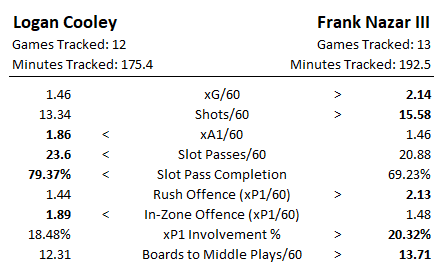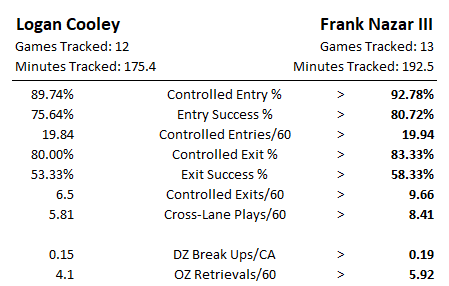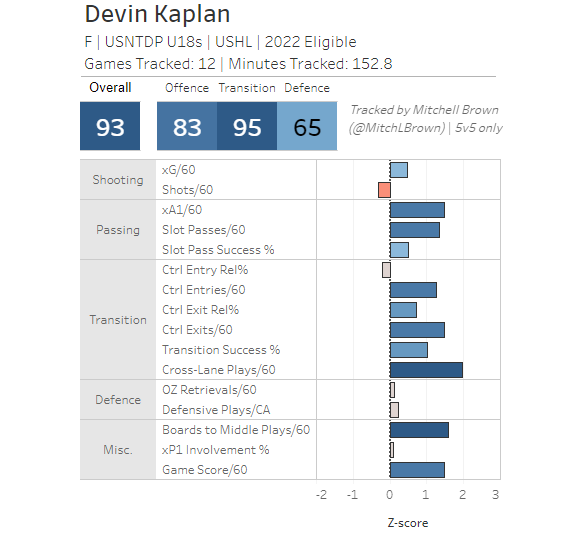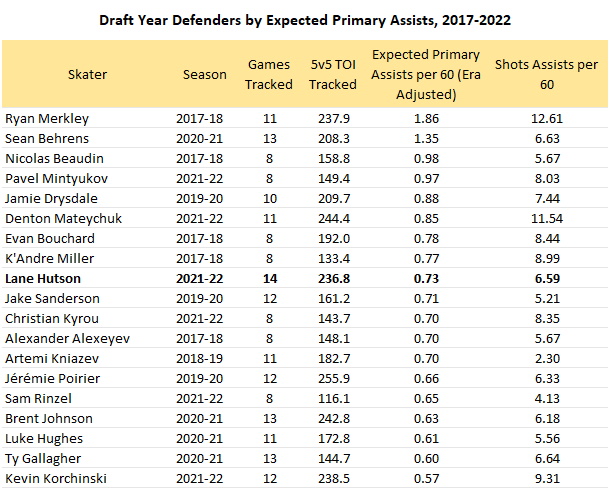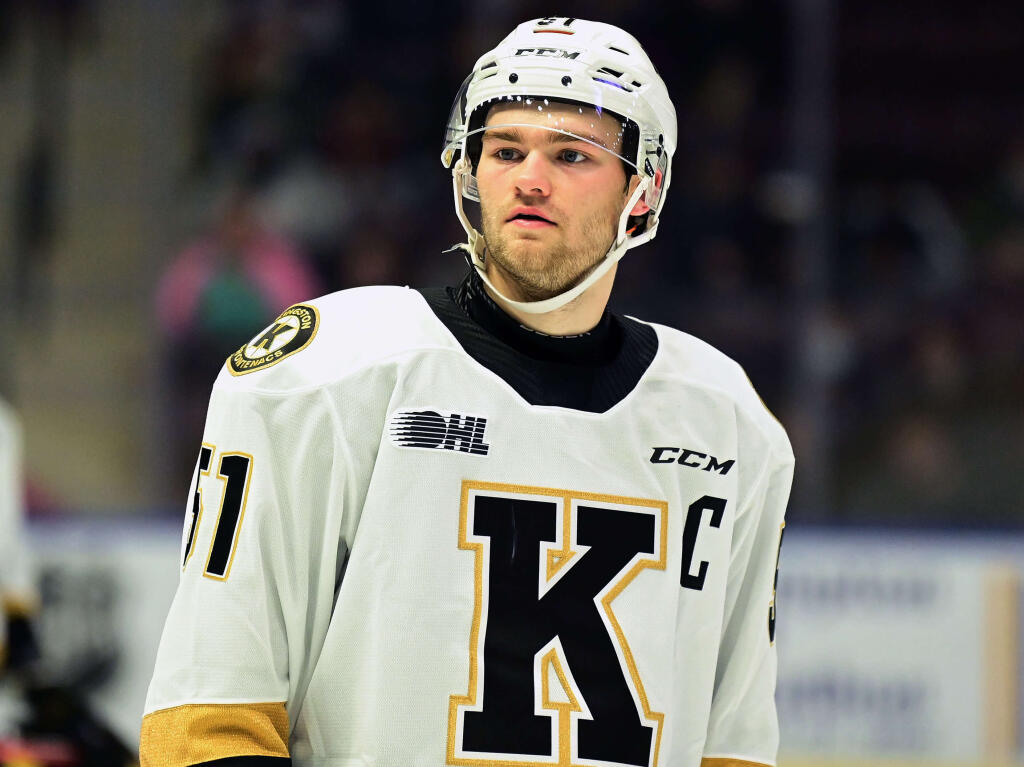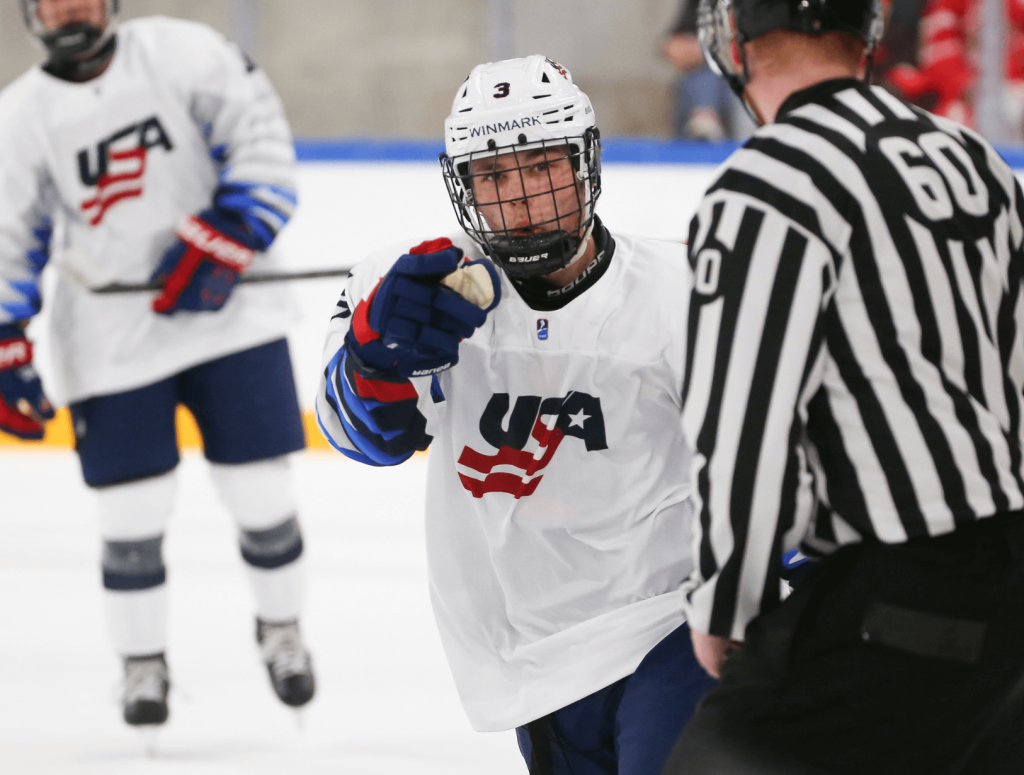9 data-driven thoughts on the USNTDP ahead of the 2022 NHL Draft
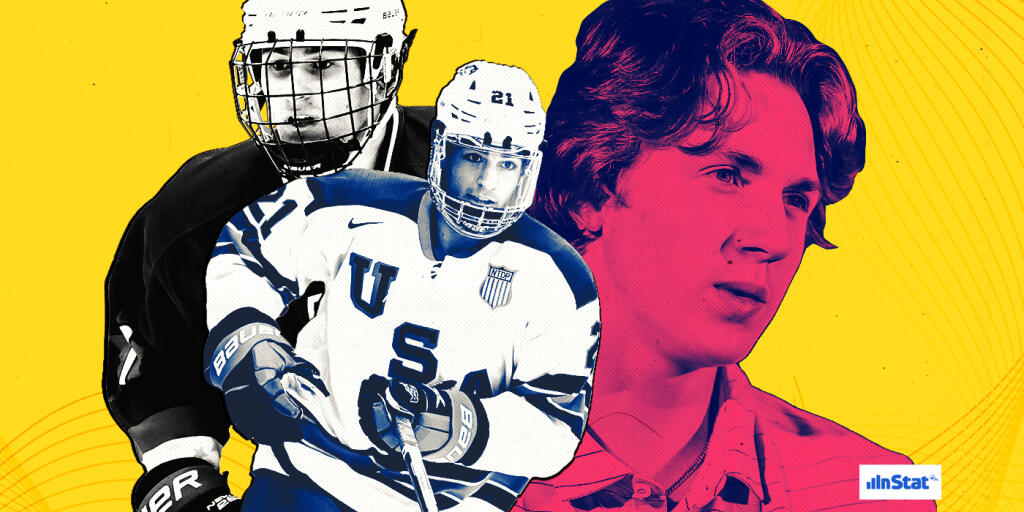
The USNTDP always makes for must-watch hockey. Not only does the Program have six likely first-round picks (and a couple more that could sneak in), it’s often a hotbed for talent available in the second round and beyond.
Because of its prominence in this draft, I tracked 14 of the NTDP’s USHL games to make better sense of the star-studded team.
This group posted the second-best offensive results in the last five NTDP U18 squads, trailing only the incredible 2019 group. Multiple players had near-historical results and several others with results that topped every CHL and USHL team tracked this season.
Among the noteworthy results that didn’t make the cut for the article include Rutger McGroarty’s dual-threat offence and Cutter Gauthier generating the second-most scoring chances of any of the 700-plus players tracked this season.
Logan Cooley vs. Frank Nazar
Logan Cooley will hear his name called before Frank Nazar III at the draft. And that’s a reasonable decision, but there’s a reason Nazar won “Highest Ceiling” in the Elite Prospects Draft Guide's scout's poll: he’s more explosive, more inside-driven, and flashes a higher level of manipulation ability.
Statistically, plenty suggests that Cooley versus Nazar is a worthwhile debate.
Cooley and Nazar’s games trended towards each other’s. Cooley started as the give-and-go, off-puck creator (much like Shane Wright) before shifting towards Nazar’s more individual skill-focused game. Nazar did the opposite. Both players bolstered their playmaking results as a result.
By season’s end, both landed in the top-five for passes to the slot per 60 and top-10 in expected primary assists per 60 (xA1/60) in the 700-plus player data set (2021-22 only). Given their starting points, Cooley was unsurprisingly more efficient as a playmaker, while Nazar’s shooting results hold the biggest statistical difference between the two players.
(Click here for definitions of the stats used in this article.)
Stylistically, Nazar’s clearly the more effective rush attacker. In fact, he led the entire data set in offence created off the rush. Cooley’s in-zone creation led the NTDP and finished 15th across all teams.
Nazar’s effectiveness off the rush also gives him the edge in most transition categories. Tracking an additional game or two could shift the close results, but Nazar has a clear advantage in two key areas. Nazar’s entry success rate is five percent higher, made more impressive by the greater degree of difficulty of his entries – highlighted by his significantly higher cross-lane plays per 60 and greater use of the inside lane.
Does this data suggest that Nazar’s a better prospect than Cooley? Of course not. But, at the very least, it’s clear there’s not much separating the two. That’s why they landed back-to-back in the top five in our final ranking.
Devin Kaplan, the unheralded playmaker
In the season’s early stages, Devin Kaplan seemed like a tertiary player on his line, winning battles and making simple passes. That initial impression proved incorrect. In fact, he’s one of the cleverest playmakers to come through the NTPD in recent memory, using his vision and passing skill to overcome skating limitations.
Overall, Kaplan posted top-10 transition results among 126 CHL and USHL draft-eligible forwards with at least seven games tracked. His 1.16 xA1/60 sits top-15, surpassing notables like Gauthier, Matthew Savoie, Jagger Firkus, and Owen Beck.
The secret to Kaplan’s success? Changing the point of attack. Where most players deke, he makes a quick lateral pass. No other draft-eligible player I tracked completes more of these cross-lane passes. That makes him one of the draft’s top play-builders in transition and nearly as effective off the cycle.
Additionally, Kaplan plays both the fast and slow game, often in succession. He scans before receiving the puck, whether he’s getting open inside space or preparing to receive a puck in the cycle, then immediately makes a pass to the inside. Just when it seems like he’s only a first-touch playmaker, he delays to draw pressure, then passes just as the defender reaches in.
Lane Hutson’s playmaking
There aren’t many playmakers more effective than Lane Hutson. Among draft-eligible defenders tracked since 2017, Hutson’s xA1/60 sits ninth. Expanding the parameters to include at 1040 blueliners I’ve tracked in the time frame, he still sits an impressive 26th.
There’s an interesting parallel between Hutson and last year’s NTDP playmaker from the blue line, Sean Behrens. Both produce proportionately few shot assists compared to the weighted equivalent. But Behrens’ xA1/60 nearly doubles Hutson’s. How? Well, it’s a rare example of tracking data reflecting translatability.
Hutson’s high-value playmaking sequences come after holding the puck for lengthy periods. He activates, head fakes, cuts back, circles the offensive zone, then finds a teammate on the other side of the slot. He throws pucks into the slot, trusting his teammates to knock down tricky passes and turn them into shots.
On the other hand, Behrens has a much more NHL-style of point-play: short touches highlighted by in-motion pass receptions to beat or draw pressure, deception to pull defenders’ sticks of his desired lane, and precise passes. No options? He’d make a simple play rather than throwing a puck into the slot.
Hutson’s style might be easier to appreciate, but he should borrow from Behrens’ playbook to get the most of his dynamism, vision, and passing skill.
Isaac Howard: inefficient high-volume
No player bounced around Elite Prospects’ 2022 NHL Draft board more than Isaac Howard. His tools suggest a top-nine forward, but his impact on games varied considerably as he sprinted ahead of the play and waited for pucks to come to him.
Once Howard received the puck, he showed a more diverse skill set than last year: deceiving then passing, completing one-touch feeds, and beating defenders with his hands. But he didn’t have much success. While he scored in the top-25 in attempted slot passes per 60, he only completed 54 percent, a rate that lands in just the 27th percentile of CHL and USHL forwards. He was inefficient in transition, posting average-to-below-average completion rates, largely due to poor passes and over-reliance on individual skill.
For all our concerns, however, an attempt to diversify is generally positive. And Howard still has the ultimate fall-back: scoring goals. He’s an off-the-pass shooter who gets open in the spaces between defenders, then launches rockets against the grain or beats the goaltender across the net.
Ryan Chesley’s progression
It’s rare for draft-minus-one players to post notable tracking results, even top prospects. The average overall grade – a weighted average of nearly 20 different tracking data stats – for draft-minus-one players sits around the 40th percentile among CHLers.
Ryan Chesley’s draft-minus-one season was in the 97th percentile of all CHLers. Not just his age. Of all players. He did everything, from defence to offence.

This season, the patterns in Chesley’s game remain strong. He uses the middle, draws pressure, looks cross-ice for passing options, and occasionally joins the rush, but patterns become problems when they’re too heavily relied on. Slow decision-making and an inability to abort plays bound to fail led to a downtick in his effectiveness in transition. To his credit, his playmaking took a step up this season, and he continued to flash stand-out skills, like slip passes, deception, and manipulation. His role also changed.
Still, Chesley’s a projectable defender, killing plays in the neutral and defensive zones in projectable ways. He looks the part of a soon-to-be NHLer. How much more he develops his game with the puck will dictate how high he slots in the lineup.
Checking in on Seamus Casey
At the midway point of the season, I wrote about the divergence between Casey’s results and his perception. As I tracked more games, Casey’s results did what I anticipated -- they improved.
Casey’s defensive results pulled closer to average, much more in line with his projectable play-killing potential and rush defence. His xA1/60 and slot passes per 60 increased significantly, albeit with his efficiency dropping.
The most encouraging part of the improved results is Casey’s breakouts. His controlled exit percentage improved (although dropped relative to the team average), he used the middle more, and he connected with cross-ice options. His results still don’t scream a top-10 pick, but they’re much more aligned with the late-first, early-second rankings.
Charlie Leddy’s breakouts
Given the NTDP’s numerous talents, it might be a surprise that Charlie Leddy posted a higher controlled exit percentage than Casey, Chesley, Tyler Duke, and Hutson. In fact, his 80.5 percent rate landed in the 84th percentile among all CHL and USHL defenceman.
Leddy’s best when resetting or delaying. He cuts back or away from pressure, then circles the net and tries a different lane. In-tight, he makes quick plays off the backhand to the inside. On retrievals, those same skills enabled him to escape with possession on a team-high 79.4 percent pressured attempts.
Then, there are the flashes of activation instincts, playmaking, and play-killing. In a different environment, perhaps these flashes become key parts of Leddy’s game. There’s upside here, despite the point totals.
2023 preview: Hunter Brzustewicz
While Leddy’s breakout results were impressive, the best zone exit results on the NTDP belonged to 2023-eligible Hunter Brzustewicz. His 91.89 percent controlled exit percentage led everyone in five years of tracking. And that’s made even more impressive by the large sample size of exits and that he missed all but three games last season due to injury.
Brzustewicz’s breakouts check off just about every box. He draws pressure before passing, creating advantages up the ice. Instead of forcing plays, he delays or cuts back to reset. He looks cross-ice for options if he can’t outright use the middle.
With the transition skill comes activation from the point and offensive skill, which should regularly feature with the OHL’s Kitchener Rangers.
2023 preview: Charlie Stramel
Even an injury that halved the season couldn’t keep Charlie Stramel’s momentum from building. He was a secondary piece with the U17s in the early stages of last season before eventually becoming one of its most efficient attackers. This season, he became a play driver.
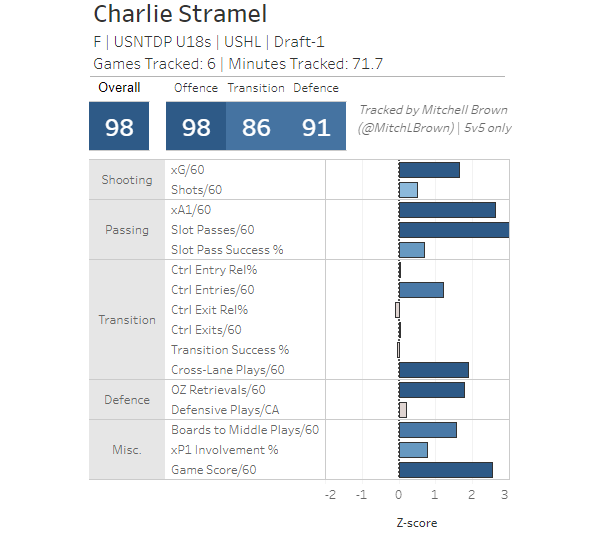
Stramel piles up the chances through individual skill and off-puck awareness while taking few low-percentage shots. Arguably even better as a playmaker, he finished second on the NTDP in slot passes per 60 while completing 78 percent. And he plays a game that should lend itself to impact at higher levels. He’s adaptable, creative, and capable of making quick-possession plays. Look for Stramel to start the season in top-10 discussions.

